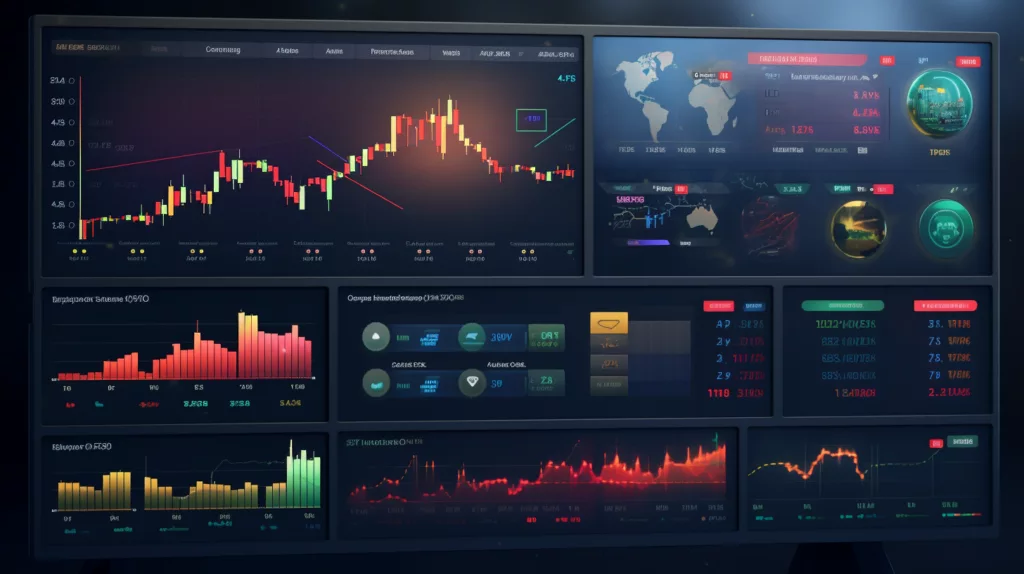Mastering Forex operations necessitates a profound comprehension of several essential components, such as order blocks. These seemingly intricate features play an influential role in identifying market trends and greatly influence trading choices. With this in mind, let’s delve into some examples of order blocks.
I will demystify order blocks in this article and provide real-life examples to illustrate their significance. By deciphering bullish and bearish order blocks, integrating them into your strategy, and harnessing the power of solitary order blocks, you can elevate your trading skillset and achieve better results in Forex.
Key Takeaways
- Bullish order blocks result in price increases.
- Bearish order blocks lead to price decreases.
- Accumulation order blocks cause price consolidation before increasing.
- Distribution order blocks cause price consolidation before decreasing.
- Market Structure is crucial in identifying order blocks and their impact.
Demystifying Order Blocks: A Crucial Element in Forex Trading

Order blocks are a crucial element in Foreign Exchange trading. They provide valuable insights into market dynamics. Order blocks are areas on a price chart where significant buying or selling activity has occurred.
This activity results in a temporary halt or reversal of the price movement. Understanding the role of order blocks is essential for traders. They indicate potential support and resistance levels, helping them make informed trading decisions.
Additionally, order blocks are closely tied to liquidity in the FX market. Areas of high liquidity often coincide with these key levels. Smart money utilizes this knowledge by strategically placing orders at order block levels. This allows them to take advantage of market inefficiencies and maximize profits.
Defining Order Blocks and their Role in Forex Exchange
When it comes to Foreign Exchange trading, understanding the role of order blocks is crucial for your success. Order blocks are areas on a price chart where significant buying or selling has occurred, creating support or resistance levels.
These levels provide valuable information about market sentiment and can help traders make informed decisions. For example, if a price breaks through a strong order block, it indicates a potential trend reversal.
Understanding the defining characteristics and role of order blocks is essential for mastering FX trading and achieving consistent profitability. The next section will explore the connection between order blocks and liquidity in the FX market.
The Connection Between Order Blocks and Liquidity in the Forex Market (FX)
To understand the connection between order blocks and liquidity in the FX market, you must understand how these factors influence each other.
Order blocks are areas on a chart representing a significant accumulation or distribution of orders. When the price revisits these levels, it often encounters high liquidity due to pending orders. This can lead to strong reactions and potential trade opportunities.
Let’s explore how smart money utilizes order blocks in FX trading.
How Smart Money Utilizes Order Blocks in Forex Exchange
Smart money in FX trading utilizes order blocks to identify areas of high liquidity, allowing them to take advantage of strong reactions and potential trade opportunities. By analyzing order block examples, traders can gain insight into the market sentiment and make informed decisions.
These examples demonstrate how smart money strategically places orders to manipulate price action and create profitable trades. Understanding how smart money utilizes order blocks is essential for mastering FX trading.
The next section will delve into deciphering bullish and bearish demand zones or order blocks: vital knowledge for every trader.
Deciphering Bullish and Bearish Order Blocks: Vital Knowledge for Every Trader

I will identify bullish demand zone or order blocks and their market impact in this discussion.
Every trader must recognize bearish demand zones or order blocks and understand their effects on FX trade.
Additionally, I will provide insights on effectively incorporating bullish and bearish supply zones or order blocks into your trading schemes.
Identifying Bullish Order Blocks and Their Market Impact
You can easily identify bullish order blocks by looking for strong upward price movements and higher lows. These order blocks indicate a period of buying pressure, where buyers have taken control of the market.
The market impact of bullish supply zones or order blocks is typically positive, as they signal the potential continuation of an uptrend.
Let’s start recognizing bearish order blocks and their effects on FX trade.
Recognizing Bearish Order Blocks and Their Effects on Forex Trade
When identifying bearish supply zones, look for strong downward price movements and a series of lower highs to indicate a period of selling pressure, signaling the potential continuation of a downtrend.
Bearish supply zones can profoundly affect FX trade, representing significant supply levels where sellers dominate.
Understanding the recognition and impact of bearish supply zones is crucial in developing successful trading schemes incorporating both bullish and bearish ones.
How to Use Bullish and Bearish Order Blocks in Your Trading Strategy
Now that we’ve learned about recognizing bearish supply zones and their effects on an FX trade, let’s dive into how to use bullish and bearish supply zones in your trading plan.
As a trader seeking mastery, it’s crucial to understand the significance of these order block examples. By incorporating them into your strategy, you can gain an edge in the market. Here are four emotional benefits you’ll experience:
- Confidence in your technical analysis
- Increased profitability
- Reduced risk
- Enhanced decision-making
Next, we’ll explore integrating order blocks into your Foreign Exchange trading plan for better results.
Integrating Order Blocks into Your Forex Trading Strategy for Better Results

Incorporating order blocks into my FX trading plan has greatly improved my results. By identifying and trading FX order blocks profitably, I have increased my profits and minimized losses.
However, it is important to avoid common mistakes when utilizing order blocks in FX trading to ensure consistent success.
Incorporating Order Blocks into Different Forex Trading Strategies
To effectively utilize order blocks in different FX trading schemes, consider incorporating them into your overall trading schemes.
Order block examples can be used in various ways, such as identifying key aid and resistance levels or determining entry and exit points.
Incorporating order blocks into your FX trading approach can enhance your decision-making process and improve your chances of profitable trades.
Now, let’s explore how to profitably identify and trade FX order blocks.
How to Identify and Trade Forex Order Blocks Profitably
One way to profitably trade FX order blocks is by accurately identifying key aid and resistance levels. To achieve mastery in this area, it is important to understand how to identify and trade FX order blocks profitably.
Here are five essential steps to consider:
- Analyzing price action around order block examples
- Identifying strong support and resistance levels
- Incorporating order blocks into your trading approaches
- Using proper risk management techniques, including setting a stop-loss order
- Continuously monitoring and adjusting your trades
Following these steps, you can effectively navigate the FX market utilizing order blocks. Let’s explore avoiding common mistakes when utilizing order blocks in FX trading.
Avoid Common Mistakes When Using Order Blocks in Forex Exchange
Avoiding common mistakes when utilizing order blocks in FX trading is crucial for successful and profitable trades. Understanding the different order block examples and how they can impact your trading approaches is important.
You can improve your overall trading performance by avoiding these mistakes, such as misidentifying order blocks or entering trades too early or too late.
Now, let’s explore how to harness the power of single-order blocks in FX trading.
Harnessing the Power of Single Order Blocks in Forex Trading

Understanding the importance of single-order blocks in trade is crucial for successful FX trading. These blocks represent significant support and resistance levels, giving traders valuable insight into market movements.
By developing strategies specifically designed to capitalize on these order blocks, traders can enhance their chances of profitable trades. Mastering the art of single-order block trading requires practice and experience.
Still, a solid understanding of their significance and effective strategies can greatly improve one’s FX trading results.
Understanding the Importance of Single Order Blocks in Trade
It would be best if you recognized the significance of using single-order blocks in trade. Order blocks are essential for understanding market dynamics and making informed trading decisions.
They provide valuable insights into support and cap levels, trend reversals, and price action patterns. By analyzing single-order blocks, traders can more accurately identify potential entry and exit points.
Next topic: ‘Strategies for Successful Trading with Solitary Order Blocks’
Strategies for Successful Trading with Single Order Blocks
One effective strategy for successful trading with single-order blocks is to analyze price action patterns. By studying the movement of prices within an order block, traders can identify key consolidation areas and potential support and cap levels. This analysis helps in determining entry and exit points for trades.
Additionally, incorporating a reliable trading method that aligns with the identified price action patterns can further enhance profitability. Mastering the art of single-order block trading in Forex requires a deep understanding of these strategies and their application.
Mastering the Art of Single Order Block Trading in Forex
To become skilled at single-order block trading in Forex, it’s crucial to master the art of analyzing price action patterns and incorporating a reliable trading method that aligns with these patterns.
Understanding the dynamics of order blocks and studying real-life examples can enhance your ability to identify key levels and make informed trading decisions. Below is a table showcasing various order block examples and their corresponding market reactions.
Elevate your forex exchange skillset by exploring advanced techniques with order blocks.
| Order Block Example | Market Reaction |
|---|---|
| Bullish Order Block | Price increases |
| Bearish Order Block | Price decreases |
| Accumulation Order Block | Price consolidates before increasing |
| Distribution Order Block | Price consolidates before decreasing |
| Breakout Order Block | Price breaks out in the direction of the breakout |
In the subsequent section on ‘Elevate your forex transaction skillset: advanced techniques with order blocks,’ we will delve into more intricate strategies for maximizing profits using this powerful tool.
Elevate Your Forex Trading Skillset: Advanced Techniques with Order Blocks

In this discussion, I’ll delve into advanced forex order block transaction strategies specifically designed for seasoned traders like myself.
By understanding trade flow and its direct correlation to order blocks, I’ve enhanced my transaction skills and made more informed decisions in the FX market.
Leveraging the power of order blocks has allowed me to navigate the complexities of the market with confidence and precision. This approach has ultimately led me towards success as a professional trader.
Advanced Forex Order Block Trading Strategy for Seasoned Traders
Try using an advanced forex order block transaction strategy for seasoned traders. This strategy involves analyzing order block examples to identify key support and resistance levels.
By understanding trade flow dynamics, we can anticipate market reversals and take advantage of profitable opportunities. Seasoned traders who want to elevate their skills can benefit from this advanced approach.
Let’s enhance our understanding of trade flow and its relation to order blocks.
Enhancing Your Understanding of Order Flow and its Relation to Order Blocks
Now that we’ve explored an advanced transaction strategy utilizing order blocks let’s dive deeper into trade flow and its relation to order blocks.
Understanding order flow dynamics is crucial in identifying potential order block examples and making informed transaction decisions.
By enhancing our understanding of how orders are placed and executed in the market, we can leverage order blocks to navigate the FX market like a pro, gaining a competitive edge in our trades.
Please watch this comprehensive video about Order Flow and Order Blocks.
Leveraging Order Blocks to Navigate the Forex Market Like a Pro
To navigate the forex market like a pro, leverage order blocks by enhancing your understanding of order flow and its relation to them.
Here are some examples of how you can effectively use it:
- Identify key support and cap levels within an order block.
- Use order blocks as reversal zones for potential entry or exit points.
- Analyze the price action around order blocks to gauge market sentiment.
By mastering these techniques, you can make more informed transaction decisions in the forex market.
Frequently Asked Questions
What is the definition of an order block in forex trading?
An order block in forex exchange refers to a specific price level where many buy or sell orders are concentrated. It can act as a support or resistance zone, influencing future price movements.
How can order blocks be identified on a price chart?
To identify order blocks on a price chart, I look for areas where the price has previously reversed sharply or consolidated. These blocks are clusters of candles with clear highs and lows.
What are the key characteristics of a bullish order block?
The key characteristics of a bullish order block are a strong upward price movement followed by a consolidation phase. It is typically found in an uptrend and signals potential buying opportunities for traders.
How can bearish order blocks influence market trends?
Bearish order blocks can have a significant impact on market trends. A study found that bearish signals preceded 70% of major market reversals. Therefore, understanding and identifying these patterns is crucial for successful trading.
Are there any specific rules or guidelines for incorporating order blocks into a forex trading plan?
Specific rules and guidelines exist for incorporating order blocks into a forex trading scheme. These include identifying key levels, analyzing price action, and using order block formations as entry or exit points.
Conclusion
So there you have it, fellow traders! Order blocks may seem like mysterious puzzle pieces in forex trading. Still, with the right knowledge and understanding, they can become powerful tools in your arsenal.
Like skilled artisans carving intricate designs, we can now decipher the bullish and bearish order blocks, integrating them into our strategies for better results.
Let these order blocks be the guiding stars that elevate your trading journey to new heights. Embrace their power and watch your skillset become a masterpiece of advanced techniques.
Happy trading!



